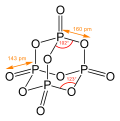Chemical structure
Chemical structure refers to the spatial arrangement of atoms and the chemical bonds that hold the atoms together. The chemical structure of a molecule can significantly influence its physical and chemical properties, including its reactivity, polarity, phase of matter, color, magnetism, and biological activity.
Overview[edit]
The chemical structure of a molecule can be described in terms of its atoms, the ways those atoms are arranged, and the chemical bonds that hold the atoms together. The chemical structure can be represented graphically as a structural formula.
Atoms[edit]
Atoms are the basic units of matter and the defining structure of elements. They are composed of three kinds of subatomic particles: protons, neutrons, and electrons. The protons and neutrons form the nucleus of the atom, while the electrons orbit the nucleus.
Bonds[edit]
Chemical bonds are the attractive forces that hold atoms together in molecules. There are several types of chemical bonds, including covalent bonds, ionic bonds, and hydrogen bonds.
Structural Formula[edit]
A structural formula is a type of chemical formula that shows the arrangement of atoms in a molecule and the bonds between them. The structural formula can be represented in several ways, including the Lewis structure, the line-angle formula, and the ball-and-stick model.
Chemical Properties[edit]
The chemical structure of a molecule determines its chemical properties, including its reactivity, polarity, phase of matter, color, magnetism, and biological activity. For example, the chemical structure of water (H2O) makes it a polar molecule, which means it has a positive charge on one side and a negative charge on the other.
See Also[edit]
Ad. Transform your life with W8MD's Budget GLP-1 injections from $75


W8MD offers a medical weight loss program to lose weight in Philadelphia. Our physician-supervised medical weight loss provides:
- Weight loss injections in NYC (generic and brand names):
- Zepbound / Mounjaro, Wegovy / Ozempic, Saxenda
- Most insurances accepted or discounted self-pay rates. We will obtain insurance prior authorizations if needed.
- Generic GLP1 weight loss injections from $75 for the starting dose.
- Also offer prescription weight loss medications including Phentermine, Qsymia, Diethylpropion, Contrave etc.
NYC weight loss doctor appointmentsNYC weight loss doctor appointments
Start your NYC weight loss journey today at our NYC medical weight loss and Philadelphia medical weight loss clinics.
- Call 718-946-5500 to lose weight in NYC or for medical weight loss in Philadelphia 215-676-2334.
- Tags:NYC medical weight loss, Philadelphia lose weight Zepbound NYC, Budget GLP1 weight loss injections, Wegovy Philadelphia, Wegovy NYC, Philadelphia medical weight loss, Brookly weight loss and Wegovy NYC
|
WikiMD's Wellness Encyclopedia |
| Let Food Be Thy Medicine Medicine Thy Food - Hippocrates |
Medical Disclaimer: WikiMD is not a substitute for professional medical advice. The information on WikiMD is provided as an information resource only, may be incorrect, outdated or misleading, and is not to be used or relied on for any diagnostic or treatment purposes. Please consult your health care provider before making any healthcare decisions or for guidance about a specific medical condition. WikiMD expressly disclaims responsibility, and shall have no liability, for any damages, loss, injury, or liability whatsoever suffered as a result of your reliance on the information contained in this site. By visiting this site you agree to the foregoing terms and conditions, which may from time to time be changed or supplemented by WikiMD. If you do not agree to the foregoing terms and conditions, you should not enter or use this site. See full disclaimer.
Credits:Most images are courtesy of Wikimedia commons, and templates, categories Wikipedia, licensed under CC BY SA or similar.
Translate this page: - East Asian
中文,
日本,
한국어,
South Asian
हिन्दी,
தமிழ்,
తెలుగు,
Urdu,
ಕನ್ನಡ,
Southeast Asian
Indonesian,
Vietnamese,
Thai,
မြန်မာဘာသာ,
বাংলা
European
español,
Deutsch,
français,
Greek,
português do Brasil,
polski,
română,
русский,
Nederlands,
norsk,
svenska,
suomi,
Italian
Middle Eastern & African
عربى,
Turkish,
Persian,
Hebrew,
Afrikaans,
isiZulu,
Kiswahili,
Other
Bulgarian,
Hungarian,
Czech,
Swedish,
മലയാളം,
मराठी,
ਪੰਜਾਬੀ,
ગુજરાતી,
Portuguese,
Ukrainian

